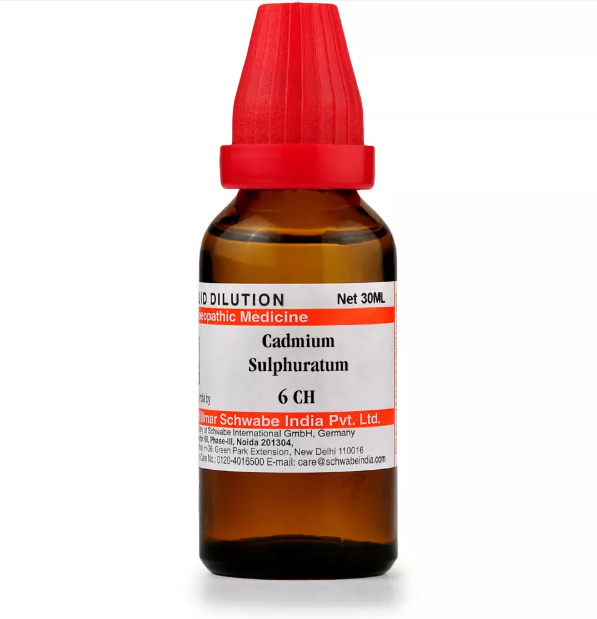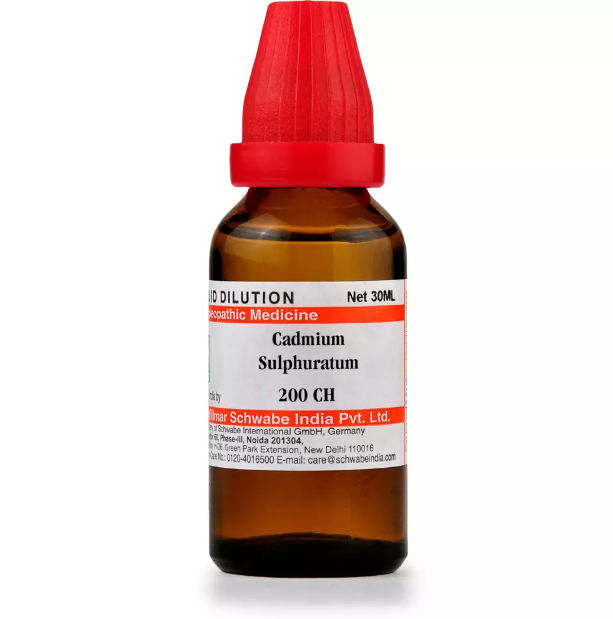CADMIUM SULPHURATUM 6C, 12C, 30C, 200C, 1M, 10M USES AND SYMPTOMS
 Cadmium Sulphuratum
Cadmium Sulphuratum
(Cadmic Sulphate)
Cadm-s.
This remedy’s pathogenesis presents symptoms of severe diseases such as cholera and yellow fever, marked by exhaustion, vomiting, and extreme prostration, often leading to death. It has significant gastric symptoms, including carcinoma of the stomach and persistent vomiting. The stomach is particularly affected, and patients need to remain still. There is chilliness and coldness even when near a fire.
Head: Unconsciousness, vertigo with spinning sensations, hammering in the head, heat.
Eyes: Corneal opacity (leucoma), blue circles around the eyes, one dilated pupil (meningitis), night blindness (nyctalopia).
Nose: Ozena, tightness at the root, nasal obstruction, polyps, nasal bone caries, boils, and ulcerated nostrils.
Face: Mouth distortion, jaw trembling, facial paralysis (left side, as in Bell’s palsy after a stroke).
Mouth: Difficulty swallowing, constricted esophagus, salty belching, intense nausea with pain and coldness, stringy offensive exudations, salty taste.
Throat: Sore throat with constant tickling, gagging, nausea worsened by deep breathing, chilliness, and aching.
Stomach: Soreness on pressure, violent nausea and retching, black vomit, vomiting mucus, bile, and blood, extreme prostration, stomach tenderness, burning and cutting pains, persistent vomiting in carcinoma, coffee-ground hematemesis.
Abdomen: Soreness, tenderness, tympanites, liver region tenderness, coldness, black offensive blood clots in stools, abdominal pain with vomiting, and tenderness.
Stool: Bloody, black, offensive, gelatinous, yellowish-green, semi-fluid with urinary suppression.
Urinary: Soreness in the urethra (urethritis), urine mixed with pus and blood (pyuria, hematuria).
Heart: Palpitations with chest constriction.
Sleep: Stops breathing when falling asleep, wakes up suffocated, fears going back to sleep, prolonged sleeplessness.
Fever: Icy coldness (Camph., Verat., Helo.), yellow fever (Crot-h., Carb-v.).
Skin: Blue, yellow, sallow, scaly, cracking, itching relieved by scratching, chloasma (yellowish stains on nose and cheeks) worsened by sun and wind exposure, chilblains.
Modalities: Worse with walking, carrying burdens, after sleep, open air, and stimulants. Better with eating and rest.
Relationship: Compare with Cadm-o., Cadm-br. (stomach pain, burning, vomiting), Cadm-i. (anal and rectal itching during the day, constipation, frequent desire, tenesmus, bloated abdomen), Zinc., Ars., Carb-v., Verat.
Dose: Third to thirtieth potency.
SYMPTOMS OF CADMIUM SULPHURATUM
Head:
Unconsciousness
Vertigo with spinning sensations
Hammering sensation
Heat in the head
Eyes:
Corneal opacity (leucoma)
Blue circles around the eyes
One pupil dilated (meningitis)
Night blindness (nyctalopia)
Nose:
Ozena
Tightness at the root
Nasal obstruction, polyps
Nasal bone caries
Boils and ulcerated nostrils
Face:
Mouth distortion
Jaw trembling
Facial paralysis, especially left side (Bell’s palsy after a stroke)
Mouth:
Difficulty swallowing
Constricted esophagus
Salty belching
Intense nausea with pain and coldness
Stringy, offensive exudations
Salty taste
Throat:
Sore throat with constant tickling
Gagging and nausea, worse with deep breathing
Chilliness and aching
Stomach:
Soreness on pressure
Violent nausea and retching
Black vomit
Vomiting mucus, bile, and blood
Extreme prostration
Tenderness, burning, and cutting pains
Persistent vomiting in carcinoma
Coffee-ground hematemesis
Abdomen:
Soreness, tenderness, tympanites
Tender liver region
Coldness
Black offensive blood clots in stools
Abdominal pain with vomiting
Stool:
Bloody, black, offensive
Gelatinous, yellowish-green, semi-fluid
Urinary suppression
Urinary:
Soreness in the urethra (urethritis)
Urine mixed with pus and blood (pyuria, hematuria)
Heart:
Palpitations with chest constriction
Sleep:
Stops breathing when falling asleep
Wakes up suffocated
Fear of sleeping again
Prolonged sleeplessness
Fever:
Icy coldness (Camph., Verat., Helo.)
Yellow fever (Crot-h., Carb-v.)
Skin:
Blue, yellow, sallow, scaly, cracking
Itching relieved by scratching
Chloasma (yellowish stains on nose and cheeks) worsened by sun and wind exposure
Chilblains
Modalities:
Worse with walking, carrying burdens, after sleep, open air, and stimulants
Better with eating and rest
selection of the potency
Individualization:
- Homeopathy is based on the principle of treating the individual, not just the disease. The unique symptoms and characteristics of the person are crucial in determining the most suitable potency.
Intensity of Symptoms:
- The intensity of the symptoms guides the choice of potency. If the symptoms are intense and acute, a lower potency (e.g., 6C, 30C) might be considered. For chronic conditions with less intensity, higher potencies (e.g., 200C, 1M) may be appropriate.
Sensitivity of the Patient:
- Some individuals are more sensitive to homeopathic remedies, while others may require higher potencies. The practitioner considers the patient’s sensitivity when selecting the potency.
Acute vs. Chronic Conditions:
- Lower potencies are often used for acute conditions, while higher potencies may be considered for chronic or long-standing issues.
Previous Response to Potencies:
- The patient’s response to previous homeopathic treatments helps guide the choice of potency. If a particular potency has been effective in the past, it may be repeated or adjusted as needed.
Vital Force and Susceptibility:
- Homeopathy views illness as a disturbance in the vital force. The practitioner assesses the patient’s overall vitality and susceptibility to determine the appropriate potency.
Aggravation or Amelioration:
- The direction of the symptom response (aggravation or amelioration) after taking a remedy can influence the choice of potency.
Miasmatic Considerations:
- In classical homeopathy, the concept of miasms (inherited disease tendencies) is considered. The practitioner take this into account when selecting the potency.
Practitioner Experience:
- The experience and preference of the homeopathic practitioner play a role. Some practitioners may have success with certain potencies based on their clinical experience.
SAFETY INFORMATION
- Do not exceed the recommended dose by physician
- Keep out of the reach of children
- Store in a cool dry place away from direct sunlight
- Maintain half an hour gap between food/drink/any other medicines and homoeopathic medicine
- Avoid any strong smell in the mouth while taking medicine e.g. camphor, garlic, onion, coffee, hing
Medicine images use for reference only selection of homeopathic medicine depends on the individual’s specific symptoms and overall constitution. Moreover, homeopathy is a holistic system of medicine that treats the individual as a whole. In addition to addressing the physical symptoms, it takes into account the emotional and mental state of the person. Consequently, it’s crucial to consult with a qualified homeopathic practitioner for personalized treatment.
The information provided on this website is intended solely for educational purposes. Always seek the advice of your physician or other qualified health provider.
